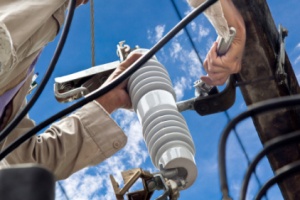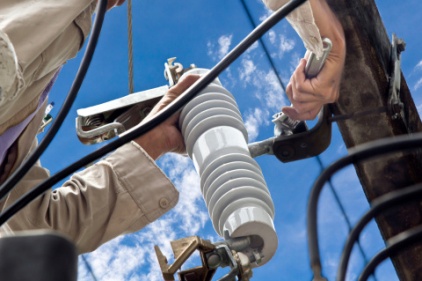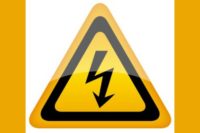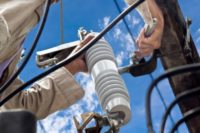 Frequently Asked Questions (FAQs) - Electric Power Generation, Transmission, and Distribution
Frequently Asked Questions (FAQs) - Electric Power Generation, Transmission, and Distribution
Maintenance and Construction (29 CFR 1910.269 and 29 CFR Part 1926, Subpart V)
Note: Earlier in 2014 OSHA issued a final rule to improve workplace safety and health for workers performing electric power generation, transmission and distribution work.
Why did OSHA decide to modify its standards for electric power generation, transmission, and distribution work?
OSHA last issued rules for the construction of transmission and distribution installations in 1972. Those provisions were out of date and inconsistent with the more recently promulgated general industry standard covering the operation and maintenance of electric power generation, transmission, and distribution lines and equipment. OSHA revised the construction standard to make it more consistent with the general industry standard and made some revisions to both the construction and general industry requirements to enhance worker safety.
The final rule will prevent approximately 20 fatalities and 118 serious injuries annually in addition to the fatalities and injuries already prevented by the existing construction and general industry standards.
When will the rule be effective?
Revised 910.269 and Subpart V will be effective on July 10, 2014. However, the compliance deadline for some provisions on fall protection, minimum approach distances, and arc-flash protection is April 1, 2015.
Where can I find a copy of the rule?
The rule is available at http://www.dol.gov/find/20140401/2013-29579.pdf*
When will compliance assistance materials be available to the public?
OSHA posted this FAQ and anticipates having other material available soon. OSHA will post these materials on this Website as they become available.
How does this new rule affect States that administer their own OSHA-approved safety and health plans?
State-plan States must have job safety and health standards that are “at least as effective as” comparable Federal standards. State-plan States have the option to promulgate more stringent standards or standards covering hazards not addressed by Federal standards.
Who must follow the final requirements?
Employers that operate or maintain electric power generation, transmission, or distribution lines or equipment must follow 1910.269. Employers with employees who perform construction work on electric power transmission or distribution lines or equipment must follow Subpart V. Note that “construction work” includes the erection of new electric transmission and distribution lines and equipment, and the alteration, conversion, and improvement of existing transmission and distribution lines and equipment.
What are the costs and benefits associated with the proposed standard?
OSHA estimates that the final rule will prevent approximately 20 additional fatalities and 118 additional serious injuries annually. OSHA estimates the total annualized cost of compliance with the final rule to be between about $47 million and $50 million
What is a host employer?
A host employer is an employer that operates, or that controls the operating procedures for, an electric power generation, transmission, or distribution installation on which a contract employer is performing work covered by the standard. Note that the host employer need not be the entity that hired the contract employer.
What is a contract employer?
A contract employer is an employer, other than a host employer, that performs work covered by the standard under contract.
What information does a host employer have to provide to a contract employer?
Before work begins, the host employer must inform the contract employer of:
- The following characteristics of the host employer’s installation when they are related to the safety of the work to be performed – nominal voltages of lines and equipment, the maximum switching-transient voltages, the presence of hazardous induced voltages, the presence of protective grounds and equipment grounding conductors, and the locations of circuits and equipment, including electric supply and communication lines and fire-protective signaling circuits;
- The following conditions when they are related to the safety of the work to be performed and known to the host employer – the condition of protective grounds and equipment grounding conductors, the condition of poles, and environmental conditions relating to safety;
- Information about the design and operation of the host employer’s installation that the contract employer needs to make the assessments required by the standard; and
- Other information about the design or operation of the host employer’s installation that is (1) known by the host employer, (2) requested by the contract employer, and (3) related to the protection of the contract employer’s employees.
What information does the contract employer have to provide the host employer?
Before work begins, the contract employer must advise the host employer of any unique hazardous conditions posed by the contract employer’s work. Also, the contract employer must advise the host employer of any unanticipated hazardous conditions found, while the contractor’s employees are working, that the host employer did not mention; the contract employer must provide this information to the host employer within 2 working days after discovering the hazardous condition.
Does the standard require the host employer to supervise contract employers’ employees or report observed violations of the standard?
No, but see the discussion of the information-transfer provisions in Section V of the Federal Register notice for a more complete explanation of host-employer responsibilities.
Must the contract employer’s employees follow the host employer’s work rules?
No. However, the host employer and contract employer must coordinate their work rules and procedures so that each employee of the contract employer and the host employer is protected as required by the standard.
What are the different types of fall protection equipment the standard requires?
Depending on the circumstances, the standard requires one of three types of fall protection:
- Personal fall arrest system. A system used to arrest an employee in a fall from a working level.
- Fall restraint system. A fall protection system that prevents the user from falling any distance.
- Work-positioning equipment. A body belt or body harness system rigged to allow an employee to be supported on an elevated vertical surface, such as a utility pole or tower leg, and work with both hands free while leaning.
What forms of fall protection must employers use to protect employees working from aerial lifts?
The standard requires employers to protect an employee working from an aerial lift using one of the following:
- A personal fall arrest system or
- A fall restraint system.
What forms of fall protection must employers use to protect employees working from a pole, tower, or similar structure?
The standard requires employers to protect an employee working at heights of more than 1.2 meters (4 feet) on a pole, tower, or similar structure using one of the following, as appropriate:
- A personal fall arrest system,
- Work-positioning equipment,
- A fall restraint system, or
- Other fall protection meeting Subpart D of OSHA’s general industry standards or Subpart M of OSHA’s construction standards, as applicable. A guardrail system meeting one of those standards is an example.
Must qualified employees climbing or changing location on poles, towers, or similar structures use fall protection?
Generally yes. Starting April 1, 2015, the standards require qualified employees climbing or changing location on poles, towers, or similar structures to use fall protection, unless the employer can demonstrate that climbing or changing location with fall protection is infeasible or would create a greater hazard than climbing or changing location without it. (Note that “climbing” includes going up or down the pole, tower, or other structure.)
How does the standard set minimum approach-distance requirements?
The standards require the employer to establish minimum approach distances that employees must maintain from exposed energized parts. The employer must base those distances on formulas set by the standard or follow default minimum approach-distance tables contained in the standard.
How does the standard treat maximum transient overvoltages?
No later than April 1, 2015, for voltages over 72.5 kilovolts, the employer must determine the maximum anticipated per-unit transient overvoltage, phase-to-ground, through an engineering analysis.
Alternatively, the employer may assume a maximum anticipated per-unit transient overvoltage, phase-to-ground, in accordance with the following table:
|
Voltage Range(kV) |
Type of Current (ac or dc) |
Assumed Maximum Per-Unit Transient Overvoltage |
|
72.6 to 420 |
ac |
3.5 |
|
420.1 to 550.0 |
ac |
3.0 |
|
550.1 to 800.0 |
ac |
2.5 |
|
250 to 750 |
dc |
1.8 |
Does OSHA provide guidance on establishing minimum approach distances?
Yes. Appendix B to the standard provides tables listing minimum approach distances for conditions common in electric power transmission and distribution work. Employers may use these tables to establish minimum approach distances under the exposure conditions covered by the tables. (Note that the final rule permits employers to continue to use the minimum approach distances in the old standards until March 31, 2015.) In addition, Appendix B provides guidance on:
- How to comply with the minimum approach-distance requirements in the standard,
- How to use portable protective gaps to limit maximum transient overvoltages at the worksite and thereby reduce minimum approach distances, and
- How to calculate minimum approach distance when employers use portable protective gaps.
What requirements does the standard adopt for employees who are unprotected from energized parts?
The standards contain two requirements related to employees working near energized parts without electrical protective equipment or live-line tools:
- When an employee uses rubber insulating gloves or rubber insulating gloves and sleeves as insulation from energized parts, the employee:
- Must put on the gloves and sleeves in a position where he or she cannot reach into the established minimum approach distance, and
- May not remove the rubber insulating gloves and sleeves until he or she is in a position where he or she cannot reach into the established minimum approach distance.
- When an employee performs work near exposed parts energized at more than 600 volts, but not more than 72.5 kilovolts, and is not wearing rubber insulating gloves, being protected by insulating equipment covering the energized parts, performing work using live-line tools, or performing live-line barehand work, the employee must work from a position where he or she cannot reach into the established minimum approach distance.
What must an employer do to protect employees from hazards posed by flames and electric arcs?
In general, the employer must:
- Assess the workplaceto identify employees exposed to hazards from flames or from electric arcs;
- Make reasonable estimates of the incident heat energy of any electric-arc hazard to which an employee would be exposed;
- Ensure that employees exposed to hazards from flames or electric arcs do not wear clothing that could meltonto their skin or that could ignite and continue to burn when exposed to flames or the estimated heat energy;
- Ensure that the outer layer of clothing worn by an employee is flame resistant under certain conditions; and
- With certain exceptions, ensure that employees exposed to hazards from electric arcs wear protective clothing and other protective equipment with an arc rating greater than or equal to the estimated heat energy.
What are the compliance deadlines?
The employer must assess the workplace for arc-flash hazards by the effective date of the final rule. In addition, the employer must ensure that employees do not wear clothing that could melt onto their skin or that could ignite and continue to burn by the effective date of the final rule. By January 1, 2015, the employer must make reasonable estimates of incident energy. Finally, the employer must provide protective clothing and other protective equipment meeting the arc-flash protection requirements of the final rule by April 1, 2015.
Must employers pay for the flame-resistant and arc-rated clothing and other arc-flash protective equipment required by the standard?
Yes. As required by OSHA’s general rules on employer payment for personal protective equipment (29 CFR 1910.132(h) and 29 CFR 1926.95(d)), employers must pay for the flame-resistant and arc-rated clothing and other arc-flash protective equipment that the electric power generation, transmission and distribution standards require.
Has OSHA provided any guidance on how to how to perform the required assessment and how to estimate incident heat energy?
Yes. Appendix E to the standard provides tables listing incident heat energies for common exposures found in electric power transmission and distribution work. Employers may use these tables to estimate incident heat energy under the exposure conditions covered by the tables. In addition, Appendix E provides guidance on:
- How to assess the workplace for flame and electric-arc hazards;
- Selecting a reasonable incident-energy calculation method under various conditions;
- Selecting reasonable parameters for use in calculating incident heat energy, including:
- Selecting a reasonable distance from the employee to the arc, and
- Selecting a reasonable arc gap.
Has OSHA provided any guidance on how to select the protective clothing and equipment required by the standard?
Yes. Appendix E to the standard provides guidance on:
- How to select clothing that does not ignite,
- How to select protective clothing with an acceptable arc rating, and
- When the standard requires arc-rated head and face protection.



